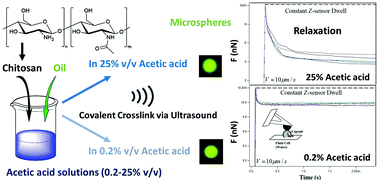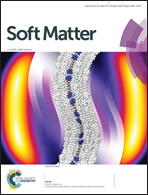Ultrasonically synthesized organic liquid-filled chitosan microcapsules: part 1: tuning physical & functional properties†
Abstract
This study reports the synthesis of tetradecane-filled chitosan microcapsules in acetic acid aqueous solutions using high intensity ultrasound at 20 kHz. The size, size distribution, and stability of microcapsules were tuned by varying the concentration of acetic acid from 0.2% to 25% v/v. After long-time storage at room temperature (more than 3 months), the microcapsules maintained their shell–core structure where the volume of the microcapsules at 0.2% acetic acid concentration increased by 8.3% due to leaking and coalescence. Microcapsules were consistently spherical and had a smooth shell surface, however, their shell thickness varied with acetic acid concentration. The relaxation behavior of individual microcapsules to an applied constant stress was measured by atomic force microscopy (AFM) to probe the shell strength and extent of crosslinking. The effect of acetic acid on the relative viscosity of chitosan aqueous solutions played a major role in microcapsule size control at low acid concentrations. With constant addition of acetic acid, amino groups in chitosan chains were acetylated partially under ultrasonic irradiation. This reduced the amphiphilicity of the shell material and therefore influenced the size, size distribution, stability and mechanical strength of the microcapsules. Apart from the acetylation effect, the counter-ion effect and the formation of covalent bond crosslinks also made contributions to the formation of stable chitosan microcapsules.



 Please wait while we load your content...
Please wait while we load your content...
